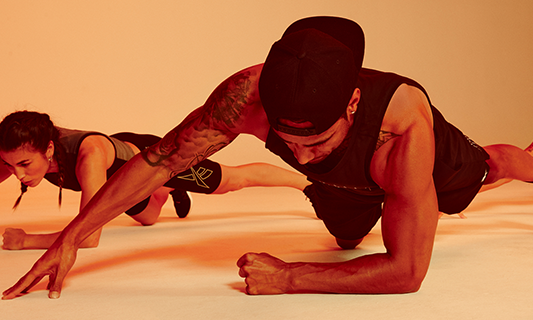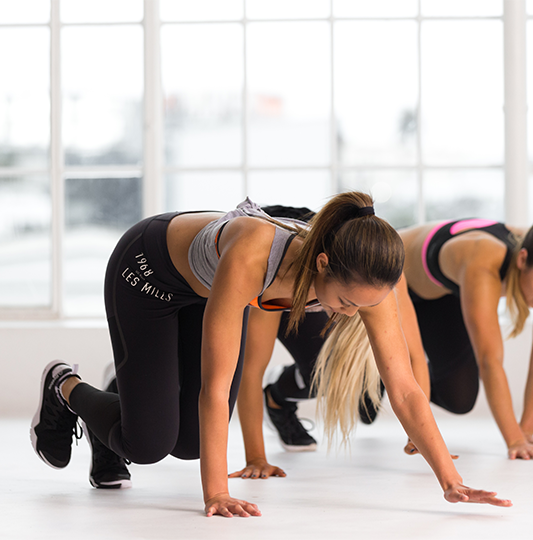CORE THINKING: AB TRAINING TRENDS OF THE FUTURE
CUTTING BACK ON CRUNCHES
Smashing out crunches and sit-ups was once the epitome of abdominal strength. But these days, intensive crunching is a thing of the past “Let’s face it,” says Bryce Hastings, Physiotherapist and Les Mills Head of Research, “We probably only crunch once a day, and that’s to get out of bed. The rest of the time we need our core to support our midsection when we’re performing full-body dynamic, loaded activities.”

Hastings explains that building this type of core strength comes from integrated core training. “This means using the core musculature while loading the upper and lower body, doing exercises like planks, hovers, and squat patterns.” Sure, there is still a place for isolated core work like crunches, says Hastings. However, training the core while loading the arms and legs produces the type of contraction we need most often.
HOVERS AND PLANKS ARE HERE TO STAY
Our team of experts universally agrees that it’s hard to beat a hover or plank. “The traditional plank holds its place as the top core training exercise,” says Kinesiologist, Dr. Jinger Gottschall. “You recruit the three-dimensional core muscles from shoulder to hip from the back to the front and both sides.”
For Dr. Gillian Hatfield, an Assistant Professor in Kinesiology and lecturer in biomechanics and athletic injuries, hovers are particularly effective because they support multiple training modalities – and this is why their popularity is primed to thrive. “Hovers are great exercises because they engage the upper body (particularly the muscles around the shoulders), the lower body (particularly the muscles around the hips), and the abdominal and low back muscles in between,” she says. “And on top of building strength, these exercises also build endurance, which is important because our core muscles need to work constantly during our daily activities.”

If you want to get the most from your hovers and planks, research shows the hover (also known as a forearm plank) elicits the most muscle activation. Or you can mix it up suggests Hatfield. “You can lift an arm or a leg to increase the demand on the muscles, or you can add movement, as you do with a Bear Crawl and get into cross-patterning core work.”
CROSS PATTERNING FOR THE WIN
Hatfield anticipates an increased focus on “cross patterning” in the years to come, which means moves like the Bear Crawl and Dead Bug could become even more prevalent. Cross patterning involves coordinated movement of the opposite arm and leg, and is a very functional type of core training that reflects the cross-patterned movements we do in everyday life. “Think about walking and running,” she explains. “Your arms and legs are working in opposition: as your right leg moves forward, so does your left arm.”

Hatfield predicts that as core training evolves to include more of these whole-body movements, it will be increasingly embraced by athletes looking to enhance performance. A recent study showed that runners who completed a six-week integrated, functional core training program improved their running economy, speed, and symmetry.
RAMPING UP REACTIVE CORE TRAINING
“There’s no point training your core to improve at core exercises,” says Hastings. “The real value of core training is the better strength in the abs, glutes and back muscles, which makes you better at lifting, running, and doing anything that requires power. Increasingly people are realizing this.”
Hastings believes the growing popularity of HIIT, functional training and things like Olympic lifting has upped the ante on core training. And he predicts this trend will continue. More people are recognizing the benefits that functional and power training has on the core – it’s termed “reactive core training”. Want to embrace reactive core training and give yourself an intense core challenge? Hastings says kicking and punching can provide a surprisingly good core workout or, if you really want to smash your abs, do forward jumps the length of a basketball court.
USING TECHNOLOGY FOR TOP TECHNIQUE
Wearable sensors are great at telling you your heart rate, cadence, steps, and calories burned, etc. But how do you know if your hips are too high during your hover? And can you tell if you’ve truly activated all of your core? Technology could soon be here to help. According to Hatfield, the core training world is perfectly primed to adopt biofeedback technology to help us perfect technique. Already, there are aspects of core training that have entered the gaming world. Electromyography is being used to identify the most effective movements, while interactive AI motion coach apps are being designed to facilitate perfect form.
Will this technology extend to new ab training equipment? Who knows?! But both Hastings and Gottschall suggest that any new-fangled ab equipment is unnecessary. “There will always be magic bullets offered to achieve that elusive six-pack,” says Hastings. “But as a general rule, if someone is standing next to a piece of equipment with a six-pack they probably didn’t get it from that particular device – so save your money and your garage space!”
Gottschall is a fan of variety, so enjoys occasionally adding equipment (weights, medicine balls, resistance bands, stability balls, TRX) to provide a new core challenge and unique type of overload. But she stresses equipment is NOT a necessity for building a strong core.
FRESH THINKING FOR INJURY PREVENTION
For years, physiotherapists and chiropractors have been helping patients recover from the acute effects of having a weak and unstable core. Now, with more people realizing a strong core can prevent back pain and reduce leg injuries, in the future we can expect an increase in people turning to fitness professionals for preventative advice – and it all hinges on core strength.
In the past, many rehabilitation specialists and fitness professionals have had an obsession with isolated exercises targeting small muscles like the transverses abdominus and the multifidus. Early research showed that in injury-free participants these small muscles turned on in advance of arm or leg movement, but their firing was delayed in people with lower back pain. This was commonly misinterpreted and the belief emerged that these small muscles were super important in “spinal stability”. However, more recent research shows this isn’t the case. “We now know the importance of engaging the global muscles of the trunk, as well as the arms and legs,” says Hatfield. Based on this we can expect even more focus on cross-patterning and using exercises involving upper and lower extremities, in addition to the core muscles.
A WASHBOARD AB WAKE-UP CALL
We’re waking up to the fact that washboard abs aren’t everything. Hastings believes the fitness industry is still too focused on aesthetic change, and for core training, this manifests as people investing excess time and effort into getting a six-pack. “We all have a six-pack, most of us have just got stuff covering it up!” He adds: “If you want to trim your waistline, you’re way better off doing something to shed body fat. But, really, it would be better to see a trend where people forget about creating washboard abs and just try to get as strong and healthy as we can.” The real value of core training is not a chiseled six-pack. Moving forward there needs to be more emphasis on core exercises not purely to work your core, but to build full-body functionality.
Source: https://www.lesmills.com/fit-planet/fitness/core-trends/
